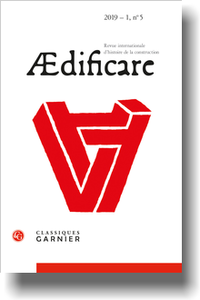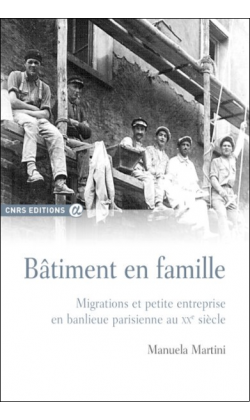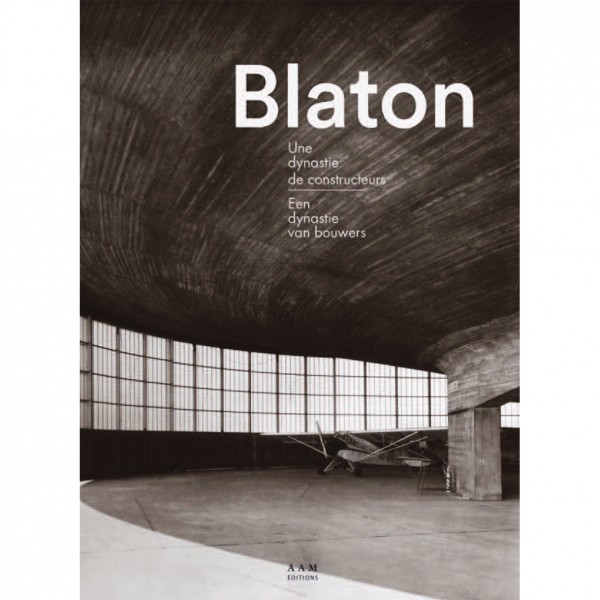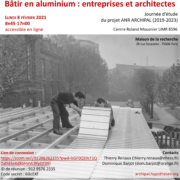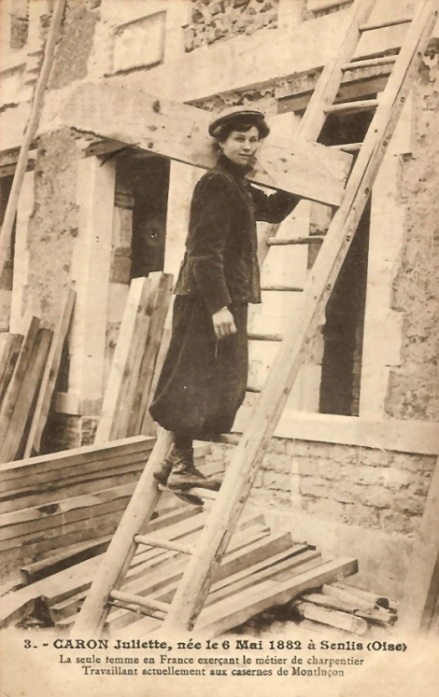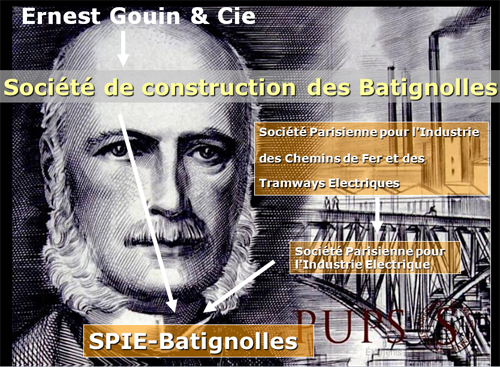Ædificare, 2019 – 1, n° 5
Revue internationale d’histoire de la construction
La cinquième livraison de la revue Ædificare est parue chez Classiques Garnier. Elle est disponible par abonnement ou par l’achat du numéro.
Ædificare est une revue semestrielle, internationale, multilingue et pluridisciplinaire couvrant le champ historique de la construction, toutes périodes et aires géographiques confondues. La revue dispose d’un Comité scientifique et d’un Comité de lecture internationaux. Tous les articles font l’objet d’une évaluation par les pairs en double aveugle. Elle paraît en publication papier et numérique aux éditions Classiques Garnier.
SOMMAIRE
Philippe Bernardi
Éditorial. Pour une requalification des déchets p. 13-16
Editorial. Towards a re-characterisation of waste p. 17-20
DOSSIER
L’entrepreneur de bâtiment : nouvelles perspectives (Moyen-Âge – XXe siècle)
Thème coordonné par Valérie Nègre et Sandrine Victor
Valérie Nègre et Sandrine Victor
Introduction/Introduction p. 23-39
L’article rappelle les objectifs principaux du numéro : éclairer la figure de l’entrepreneur de bâtiment sur une longue période (du Moyen Âge au XXe siècle) ; centrer les recherches sur les individus, plutôt que sur l’entreprise ; prêter plus d’attention aux « petits entrepreneurs » ; rendre compte de la diversité de leurs occupations. Après un rappel des réflexions développées depuis les années 1980 sur la notion d’entrepreneur, les contributions des auteurs sont examinées au regard de l’historiographie récente.
This article reviews this issue’s main goals: shedding light on the figure of the building contractor over a long period (from the Middle Ages to the twentieth century); focusing research on individuals rather than on businesses; paying more attention to “small contractors”; and drawing attention to the diversity of their occupations. After reviewing thought developed since the 1980s about the notion of the contractor, the authors’ contributions are examined in light of recent historiography.
Cécile Sabathier
La figure d’entrepreneur du bâtiment au prisme des comptabilités des chantiers urbains. Le cas d’un parcours individuel à Albi aux XIVe et XVe siècles / The Building Entrepreneur through the Municipal Accounts of Urban Construction Sites. An Individual Career Path in Albi in the Fourteenth and Fifteenth Centuries p. 41-55
Cette contribution propose d’interroger la figure d’entrepreneur du bâtiment à partir de parcours individuels à Albi aux XIVe et XVe siècles, en centrant sur le maître maçon Pos de Peiraficha. Compétence, réputation, cumul des engagements, insertion dans les cercles de décision : il apparaît, à la première lecture des sources, comme un véritable entrepreneur. Pourtant, les possibilités d’entrepreneuriat de ces maîtres-artisans au sein du marché concurrentiel des travaux publics semblent limitées.
This contribution aims to question the figure of the building contractor based on individuals’ careers in Albi in the fourteenth and fifteenth centuries, focusing on the master mason Pos de Peiraficha. With his competence, reputation, large number of commitments, and participation in decision-making circles, upon an initial reading of the sources, he appears to be a true contractor. Yet the contracting potential of these master craftsmen in the competitive public works market seems to have been limited.
Miquel Àngel Fumanal Pagès
Entrepreneurs et innovation dans l’art à Gérone au XIVe siècle / Entrepreneurs and Innovation in Art in Fourteenth-Century Girona p. 57-75
Après le long siège de l’armée de Philippe le Hardi en 1285, Gérone et sa région vécurent une période de stagnation suivie d’un élan artistique, en raison de nombreux facteurs. Le plus important est lié à l’immigration et à l’arrivée d’entrepreneurs, dont des tailleurs de pierre, des argentiers, des verriers et autres. Ce sont les responsables de l’innovation artistique du nord-est de la Catalogne depuis les années 1300.
Due to many factors, after the lengthy siege at the hands of Philip the Bold’s army in 1285, Girona and its region underwent a period of stagnation followed by an artistic boom. The most important factor was related to immigration and the arrival of contractors, including stonecutters, silversmiths, glassmakers, and others. They were responsible for the artistic innovation in northeastern Catalonia beginning in the 1300s.
Léonore Losserand
Contribution à l’histoire des entrepreneurs. Guillaume de La Vergne, un exemple parisien (? – 1710) / A Contribution to the History of Building Contractors. Guillaume de La Vergne, an Example from Paris (?–1710) p. 77-92
La carrière de Guillaume de La Vergne, actif à Paris entre 1699 et 1710, est un exemple de la diversité des commandes exécutées par les entrepreneurs. Son parcours est restitué à partir d’archives inédites permettant de catégoriser sa clientèle. Ces sources montrent que le maître maçon travaillait pour une clientèle privée, pour la municipalité et pour les institutions ecclésiales. L’étude des contrats fait apparaître différents degrés d’implication en fonction des commanditaires.
The career of Guillaume de La Vergne, active in Paris between 1699 and 1710, is an example of the diversity of projects executed by contractors. His career is brought back to life here using unpublished archives that allow us to categorize his clientele. These sources show that the master mason worked for private clients, for the municipality, and for ecclesiastical institutions. The study of contracts reveals different degrees of involvement depending on the party commissioning the work.
Catherine Isaac
Le rôle des entrepreneurs dans la construction des ouvrages d’art des États de Languedoc. L’exemple de Jean Chauvet, entrepreneur du pont de Lavaur (Tarn, 1773-1782) / The Role of Contractors in Building Eighteenth-Century Languedoc Bridgework. The Case of Jean Chauvet in Building the Lavaur Bridge (Tarn, 1773–1782) p. 93-118
Au xviiie siècle, les États de Languedoc mènent une ambitieuse politique de travaux. Cet article met en lumière les actions et l’apport réel de l’entrepreneur, Jean Chauvet, dans la construction du pont de Lavaur (Tarn) en s’appuyant sur les nombreux documents, inédits, qu’il a rédigés et dessinés. Loin d’être un simple exécutant, il se révèle capable de concevoir une structure complexe, faisant montre d’une intelligence technique indispensable à la construction de grands ouvrages.
In the eighteenth century, the Etats (provincial assembly) of Languedoc had an ambitious public works policy. This article highlights the actions and the real contribution of the contractor Jean Chauvet in the construction of the Lavaur Bridge (Tarn) by drawing upon numerous unpublished documents that he compiled and devised. Far from being a simple executor, he was able to design a complex structure, showing a technical intelligence essential for the construction of large works.
Charlotte Duvette
L’évolution de la maison urbaine à Paris à la fin du XVIIIe siècle. Le rôle de l’entrepreneur de bâtiment : propriétaire et constructeur ? / Urban House Development in Paris at the End of the Eighteenth Century. The Role of the Building Contractor – Owner or Builder? p. 119-153
Laissée de côté jusqu’à maintenant par l’historiographie, l’importance de la « maison urbaine » parisienne émerge pourtant clairement à travers l’effervescence constructive qui domine la capitale à la fin xviiie siècle. La mise à jour des documents d’archives qui se réfèrent à leur conception est sans équivoque : les entrepreneurs de bâtiments – maitres-maçons ou architectes – font partie de ses principaux acteurs. C’est à travers l’étude de leur production, et une confrontation des sources, que l’on peut saisir les caractéristiques de l’évolution de ce type d’habitat.
Left by the wayside until now by historiography, the importance of the Parisian maison urbaine emerges clearly if we take a look at the surge in construction that dominated the capital at the end of the eighteenth century. The archival documents available that make reference to the maison urbaine’s design are unequivocal: building contractors—master masons or architects—were among its main agents. The study of their production and a comparison of the sources enable us to understand the characteristics of the development of this type of dwelling.
Jelena Dobbels
The General Contractor in Belgium, a Building Actor with a Mixed Profile (1870-1930) p. 155-172
L’article présente une analyse des archives des Entreprises Générales Henri Ruttiens et Fils et Louis De Waele. Il vise à comprendre le contexte de création de ces entreprises et le profil des deux entrepreneurs généraux belges, durant la période 1870-1930. En comparant les éléments recueillis aux recherches existantes sur la professionnalisation des entrepreneurs généraux, il apparaît clairement que ces entrepreneurs belges présentaient un profil mixte. Par ailleurs, cette analyse fournit les grandes lignes pour de futures recherches sur les archives d’autres entrepreneurs généraux.
This article presents an analysis of the archives of Les Entreprises Générales Henri Ruttiens et Fils and Les Entreprises Louis De Waele. It aims to understand the context of the creation of these companies and the profile of the two Belgian general contractors during the period 1870–1930. Comparing the information gathered with existing research on the professionalization of general contractors, it is clear that these Belgian contractors had a mixed profile. In addition, this analysis provides an outline for future research on the archives of other general contractors.
Alejandro González Milea
Contratistas de obra pública en la frontera norte de México (1919-1934). La mirada del “Departamento de Edificios” de la Secretaría de Comunicaciones y Obras Públicas (SCOP) / Public Works Contractors at the Northern Mexico Border (1919–1934). A Look at the Communications and Public Works Ministry’s “Building Department” p. 173-192
Au début du XXe siècle, le gouvernement mexicain entreprit un ambitieux programme de construction et de réparation des édifices publics construits près de la frontière nord du pays. Pendant plusieurs années, les architectes et les ingénieurs du Secretaría de Comunicaciones y Obras Públicas (Ministère des Communications et des Travaux Publics) préparèrent les dossiers de consultation des entreprises. L’État choisit ensuite différents types d’entrepreneurs du bâtiment. Une étude de plusieurs cas permet de mettre au jour la diversité de leur profil.
At the beginning of the twentieth century, the Mexican government embarked on an ambitious program to construct and repair public structures built near the country’s northern border. For several years, the architects and engineers of the Secretaría de Comunicaciones y Obras Públicas (SCOP) (Ministry of Communications and Public Works) prepared business consultation files. The State then selected different types of building contractors. A study of several cases reveals the diversity of their profiles.
Cédric Perrin
De l’indépendant à l’entrepreneur. Les artisans du bâtiment en France des années 1930 aux années 1970 / From Self-Employed Worker to Entrepreneur. Construction Artisans in France from the 1930s to the 1970s p. 193-212
L’article se propose de suivre les artisans du bâtiment au sein d’un artisanat qui s’organise et se transforme au XXe siècle et dont il représente une part majeure et croissante. Jusqu’au milieu du siècle, l’artisan du bâtiment est un homme de métier, un ancien ouvrier qui poursuit pour son propre compte son activité en travaillant seul. Recrutant des ouvriers, investissant, communiquant…, ils deviennent de véritables entrepreneurs, mais en suivant de multiples voies qui laissent la place à un entrepreneuriat de l’artisanat du bâtiment diversifié.
This article aims to trace the careers of building craftspeople within a body of craftspeople that developed and transformed during the twentieth century and of which building represented a major and increasing part. Until the middle of the century, building craftspeople were tradespeople, former workers who pursued their activity on their own behalf by working alone. By recruiting workers, investing, communicating, and so on, they became true contractors. However, they did this by following multiple paths, which led to diversified craft-based construction contracting.
COMPTES RENDUS
Frédéric Épaud, La charpente de la cathédrale de Bourges. De la forêt au chantier (Philippe Bernardi) p. 215-219
Karine Boulanger, Cédric Moulis (dir.), La pierre dans l’Antiquité et au Moyen Âge en Lorraine. De l’extraction à la mise en œuvre (Jean-Pierre Gély) p. 219-222
Bernard Espion, Michel Provost, Romain Wibaut, Ine Wouters (dir.), Patrimoines de fonte, fer et acier – architecture et ouvrages d’art (Michel Moussard) p. 222-224
Franz Graf et Giulia Marino, 1931-2014. Les multiples vies de l’appartement-atelier Le Corbusier (Nathalie Simonnot) p. 225-228
COMPENDIA
The Building Contractor. New Perspectives (Middle Ages– Twentieth Century) (Valérie Nègre and Sandrine Victor) p. 231-232
The Building Entrepreneur through the Municipal Accounts of Urban Construction Sites. An Individual Career Path in Albi in the Fourteenth and Fifteenth Centuries (Cécile Sabathier) p. 232-233
Entrepreneurs and Innovation in Art in Fourteenth-Century Girona (Miquel Àngel Fumanal Pagès) p. 234- 235
A Contribution to the History of Building Contractors. Guillaume de La Vergne, an Example from Paris (?–1710) (Léonore Losserand) p. 235-236
The Role of Contractors in Building Eighteenth-Century Languedoc Bridgework. The Case of Jean Chauvet in Building the Lavaur Bridge (Tarn, 1773–1782) (Catherine Isaac) p. 236-237
Urban House Development in Paris at the End of the Eighteenth Century. The Role of the Building Contractor – Owner or Builder? (Charlotte Duvette) p. 238-239
The General Contractor in Belgium. A Building Actor with a Mixed Profile (1870–1930) (Jelena Dobbels) p. 239-240
Public Works Contractors at the Northern Mexico Border (1919–1934). A Look at the Communications and Public Works Ministry’s “Building Department” (Alejandro González Milea) p. 241-242
From Self-Employed Worker to Entrepreneur. Construction Artisans in France from the 1930s to the 1970s (Cédric Perrin) p. 242-243
PRESENTATION DES AUTEURS ET RESUMES p. 245-252

